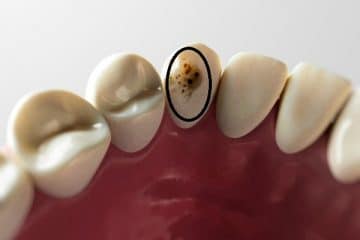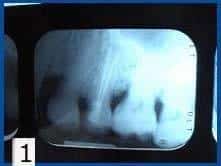Quick Facts About Tooth Cavity
| A | B |
|---|---|
| Alternative Name(s) | Dental caries, tooth decay |
| Description | A hole in a tooth that develops from tooth decay |
| Causes | Plaque buildup, eating lots of sugary snacks and poor oral hygiene |
| Symptoms | Tooth pain, tooth loss, sensitivity to hot or cold, visible holes in teeth |
| Types | Smooth surface, Pit and fissure, Root |
| Treatment | Dental fillings, root canal therapy, tooth extraction |
| Prevention | Brushing your teeth twice a day, flossing daily, eating a healthy diet, and seeing your dentist for regular checkups |
When your dentist says you have a cavity in your tooth, the first question that comes to mind is “What does a cavity look like?” unless you’ve had one before. A cavity in the tooth or teeth is a hole that has developed as a result of bacterial action on the affected tooth or teeth.
A cavity can be difficult to identify. You may have to visit a dentist to ascertain that you have a cavity in your tooth or teeth. It may appear as discoloration of your teeth or a tiny hole or crack that you can feel with your tongue. Whichever way it appears, you can be sure they come with some discomfort that may be ignored at the early stages.
In this article, we will help you identify what a cavity looks like and how you can tell if you have a cavity in your tooth or teeth before you get to a doctor. Also, you will know what the cavity looks like in an x-ray, at its beginning stage, and what you can do to prevent cavities.
What is Tooth Cavity and What is it Like?
A tooth cavity is the latter stage of tooth decay. It is primarily the presence of a hole or any opening on your tooth as a result of poor oral hygiene, bacterial activity in the mouth, and the prolonged presence of sugary food materials in the mouth. The Tooth cavity affects the enamel, that is the strong white part of the teeth, but its symptoms can be felt on the gums too.

Tooth cavities can be a tricky thing to spot as one can easily pass the tooth damage off as what will come off with time. Sometimes, what we call tooth cavity has not progressed to that stage, it is only tooth decay. However, if it is left untreated, a tooth cavity is inevitable. Your dentists may also be unable to conclude that a tooth discoloration or what feels like a crack or hole on the tooth is a cavity until they’ve done an x-ray.
The tooth cavity appears as a dark coloration on the teeth. It may appear on the crown, at the back, or the front of the tooth. In some cases, it may have the same color consistent with the tooth but a hole or crack that you may be able to feel with your tongue will give it away.
What Does a Cavity Look Like in the Beginning?
The beginning of the tooth cavity is the accumulation of bacteria and plaque on the tooth. In the beginning, the tooth cavity is characterized by discoloration of the tooth – plaque – as a result of the interaction between the bacteria in the mouth and the sugary foods that the affected individual consumes. The affected tooth may not change color at the beginning, but as it progresses, yellow discolorations begin to appear on the tooth. With time, the yellow discolorations thicken and become brown, mostly on one spot, and the enamel begins to get weaker, as a result of gingivitis.
The prolonged presence of the discoloration breeds more bacteria, and since the enamel is weak, they create a hole or crack through which they can gain entry into the tooth.
Signs of Tooth Cavity
You can tell that you have a tooth cavity when you begin to feel any or a combination of these signs and symptoms. They include:
Tooth Sensitivity
This is the most common symptom of the tooth cavity as it exposes the possibility of an opening on the teeth, allowing the entry of food or drinks in their extreme temperatures, into the tooth. The contact of cold drinks and hot food with the nerve endings present in the tooth implies that there’s a crack or hole in the tooth.
Tooth sensitivity can vary in severity, depending on how big the hole or crack on the affected tooth is, or how many teeth are affected by the symptom.
Bad Breath
Bad breath can arise as a result of bacterial abundance in the mouth. When an individual has resumed good oral hygiene and there’s still the issue of bad breath, chances are bacteria is present in teeth cracks, and holes.
Toothache
Exposure of the internal environment of the tooth to cold drinks, air, or food means the nerves feel these stimuli more and consequently have a more than normal response. Toothache arises as a result of the overwhelming sensation received by the nerves in the tooth as a result of a hole or crack in the affected tooth.
Bleeding or Swollen Gums
At the beginning of cavity development on a tooth, it is common that plaques and tartar are present between the tooth and the gum, this may cause gingivitis, which is characterized by bleeding and swollen gum. A progression from this stage leads to a tooth cavity. You can sort out gum diseases at a pediatric dentistry in queen creek should you need help.
Hole in the Tooth
The most obvious sign of a tooth cavity is the presence of a hole or a crack that you can easily feel with your tongue. The hole in the tooth allows other symptoms such as tooth sensitivity and toothache to arise.
Tooth Discoloration
Discoloration of the tooth may exist when there is yet to be a hole in the tooth. It can also be there alongside a hole in the tooth. However, you need confirmation from a dentist to make sure your tooth discoloration is pointing towards the tooth cavity.
What Does Cavity Look Like in an X-ray?

When your dentist needs to confirm if you have cavities on more than one tooth, they usually prescribe an x-ray. What they look for on the x-ray image of your teeth is the presence of dark colorations or shadows on the white that represents your teeth.
Tooth cavities in the x-ray appear as dark colorations on the teeth whites or as shadows in the images.
Can a Cavity Go away on its own?
Tooth cavity is permanent damage done to the teeth by the demineralization of the enamel. It cannot be reversed, and it does not go away on its own. While the bacteria that has caused a hole in the tooth can be reduced or eliminated, the hole it has created can only be filled.
Tooth filling helps to address the symptoms of tooth cavity by protecting the nerve endings in the teeth from the hot or cold food and beverages you may take, hence, it eliminates tooth sensitivity and toothache.
Preventing Tooth Cavity
The tooth cavity arises as a result of the demineralization of the tooth. Therefore, you can prevent demineralization by practicing good oral hygiene and following the right diet. It is easier and cheaper to prevent a cavity than to treat it.
Good oral hygiene involves using fluoride-containing toothpaste and a brush to wash your teeth at least twice daily. Floss every day. Limit your consumption of sticky, sugary foods, especially gums and candies. Also, visit your dentist regularly to expose any potential dental threat.
Eat foods that are rich in minerals such as calcium and magnesium, as they are important in strengthening your teeth.
Final Thoughts
Tooth cavities are holes or cracks present on the teeth. They appear as a result of prolonged bad oral health that has encouraged the growth of bacteria and the consequent demineralization of the enamel. Tooth cavity is a later stage of tooth decay.
The content is intended to augment, not replace, information provided by your clinician. It is not intended nor implied to be a substitute for professional medical advice. Reading this information does not create or replace a doctor-patient relationship or consultation. If required, please contact your doctor or other health care provider to assist you in interpreting any of this information, or in applying the information to your individual needs.



